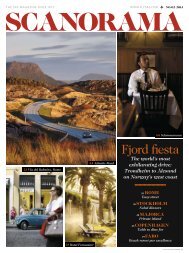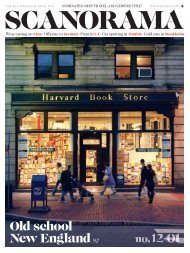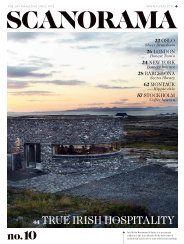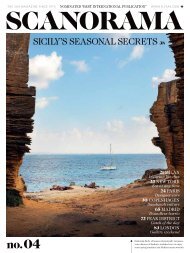Old school New England 92 - Scanorama
Old school New England 92 - Scanorama
Old school New England 92 - Scanorama
Create successful ePaper yourself
Turn your PDF publications into a flip-book with our unique Google optimized e-Paper software.
the thin-bearded Cornelissen decided to<br />
switch from seller to producer in 2000<br />
after a blind tasting of an Etna wine at<br />
a restaurant in Modica. “The first bottle<br />
was a bit harsh, very green in tannins, but<br />
it was eye-opening,” he recalls.<br />
After years of burgundy and Barolo,<br />
Cornelissen decided to go back to nature<br />
and take a radically different approach to<br />
expressing Etna’s terroir. He adds nothing<br />
to his wine and leaves it unfiltered. In<br />
place of oak barrels, he ages his wines in<br />
400 liter terracotta jars that are buried in<br />
the volcanic soil inside his garage.<br />
“I wanted to imagine how people made<br />
wine in the past. Over 2,000 years ago<br />
they were making wine on Etna, and I<br />
don’t think the Romans would have put<br />
up with drinking vinegar.”<br />
Cornelissen even traveled to Georgia’s<br />
Ka k heti region to meet farmers who have<br />
long used amphorae in wine making. To -<br />
day, he makes 20,000 bottles of his allnatural<br />
wine and prides himself on his<br />
hands-on approach, which includes<br />
painting the labels on his prized Magma<br />
vin tage. “My philosophy is this: the person<br />
who makes the wine should be the<br />
one to prune the vine, because the vine<br />
is everything.”<br />
Agriculture on Etna can be hard going.<br />
Summers are hot and dry; winters can be<br />
cold and harsh. Grapes see big fluc tu a tions<br />
in daytime and nighttime temper atures,<br />
and October, traditionally the har vest<br />
month, gets the most rain, making growers’<br />
lives a nightmare as they mull over<br />
the best time to pick. Rocky de bris left<br />
behind by recent lava spills restricts acreage,<br />
forcing some to plant vines on steep<br />
gradi ents. On sharp slopes make shift<br />
chairlifts are used to transport grapes.<br />
Workers, who pick by hand, communicate<br />
with their colleagues at the base of<br />
the hill by signaling with colored rags.<br />
When we visit Tasca d’Almerita’s Tascante<br />
estate on Etna, laborers are busy<br />
picking up rocks one by one to clear<br />
away a re cently planted field. The rocks<br />
are then re cycled to build storage huts<br />
and walls that line the label’s terraced<br />
vineyard. The scene recalls agriculture<br />
as practiced by the ancient Greeks, who<br />
settled on Etna 2,700 years ago.<br />
MARCO DE GRAZIA HAS JOINED the ranks of<br />
so phisticated winemakers eager to elevate<br />
Etna’s reputation in viticultural circles.<br />
A wine importer who moved to Etna<br />
in 2002, de Grazia has three decades of<br />
experience helping growers up and down<br />
Italy improve their own labels and prime<br />
them for export. But when he came across<br />
Hot rock: Etna<br />
smokes away in<br />
the distance<br />
the wines here, he finally got the urge to<br />
get his hands dirty.<br />
“Never in my wildest dreams did I think<br />
I’d be a grower but I see great potential,”<br />
says de Grazia as he tucks his pruning<br />
shears into his breast pocket. “It’s a cross<br />
between Burgundy and Piedmont. On my<br />
label I even call it the ‘Burgundy of the<br />
Mediterranean.’ ”<br />
Over dinner, we taste his 2008 Calderara<br />
Sottana. During the meal, the wine<br />
opens up and grows deeper and becomes<br />
silkier. While the bulk is nerello mascalese,<br />
he adds a touch of nerello cappuccio<br />
grape, which he describes as “fleshier,<br />
the merlot to mascalese’s cabernet.” To -<br />
day, Tenuta delle Terre Nere produces<br />
160,000 bottles, and de Grazia has four<br />
growths of which he is very proud, including<br />
one made from vines that predate the<br />
phylloxera epidemic.<br />
Next to his winery in Randazzo, a town<br />
on the northwestern edge of Etna that has<br />
been lucky enough to escape the volcano’s<br />
wrath, we try a few more wines over lunch<br />
at the popular trattoria San Giorgio e il<br />
Drago housed, fittingly, in a former cantina.<br />
The Anzalone brothers, Pippo and<br />
Daniele, keep patrons’ glasses filled with<br />
local vintages and pair them with sumptuous<br />
plates of rabbit and polpette (meatballs)<br />
that are skillfully prepared by their<br />
mother, Signora Paola, 79. She rules with<br />
Uphill struggle: Nerello mascalese vines<br />
a firm hand from her perch in the kitchen,<br />
often telling off her sons if they are slow<br />
to pick up orders. It’s early afternoon and<br />
the rustic dining room is close to empty,<br />
but in future the untiring Paola may need<br />
to put in overtime. If Etna’s vintages keep<br />
racking up top scores, it won’t be long be -<br />
fore the food and wine crowd is clamoring<br />
for a table. �<br />
� GO TO ITALY SAS takes you to Rome, Milan,<br />
Venice and Bologna. Book your trip at www.flysas.<br />
com or use your EuroBonus points starting at 18,000<br />
points one way<br />
SCANORAMA DECEMBER 2011/JANUARY 2012 79<br />
�












